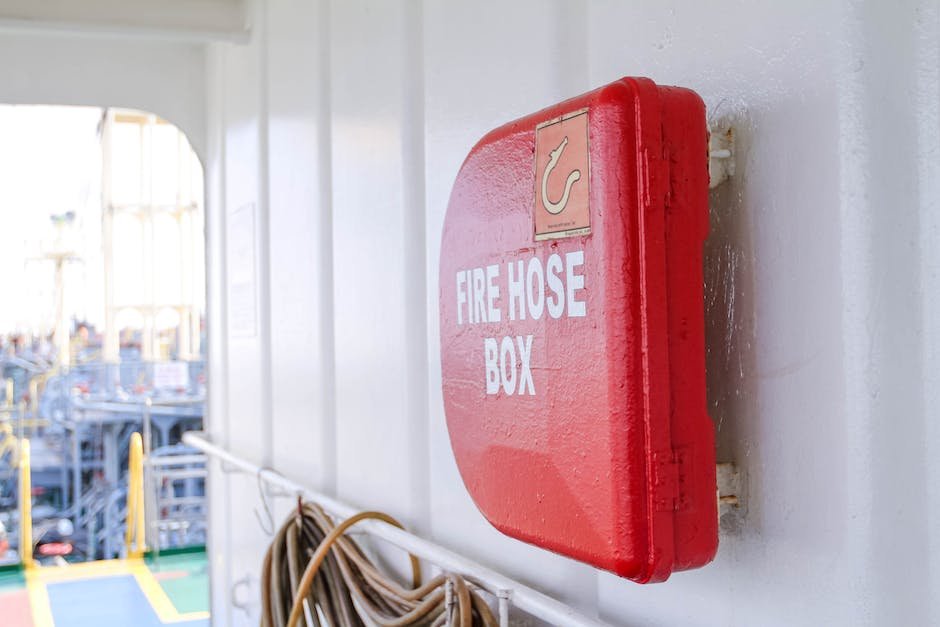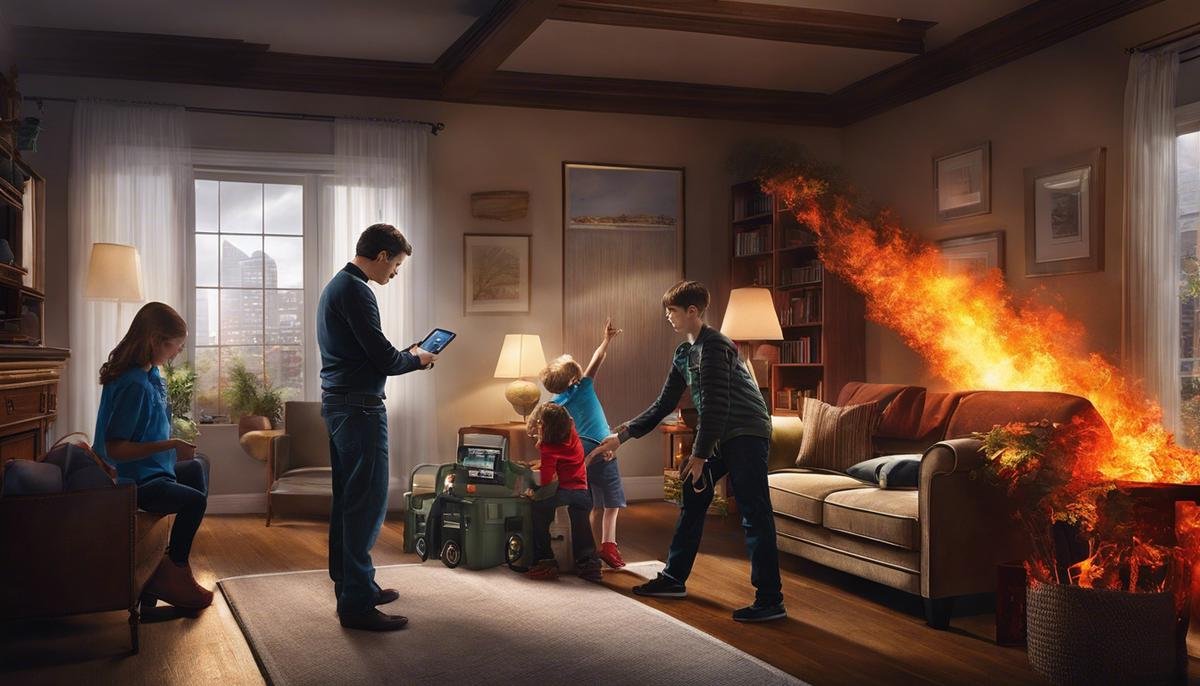
Fire safety is a critical concern for every household, but when it comes to individuals on the autism spectrum, it necessitates a specialized approach. Sensory processing challenges common among autistic people can greatly affect how they perceive and respond to emergencies, including fires. Recognizing this, it is crucial to evaluate and adapt fire safety measures to address their unique needs. This essay aims to empower the general public with knowledge on tailoring fire safety plans, ensuring those with autism are not only safeguarded but also comfortable with necessary procedures. By understanding sensory responses, creating personalized escape strategies, and fostering communication with fire safety professionals, we lay the groundwork for a comprehensive protective environment. Furthermore, with advances in safety tools and technology, we have the opportunity to harness these innovations for the benefit of the autism community, assuring that safety becomes inclusive and accessible to all.
Understanding Sensory Needs and Responses
Sensory Sensitivities and Fire Safety – A Guide for Parents with Autistic Children
As a parent, there’s nothing more important than ensuring the well-being and safety of our little ones. When it comes to children with autism, the stakes can be even higher. Many autistic individuals experience sensory differences that can greatly impact their response to emergencies, including fires. Knowing how to navigate these unique challenges can be a lifesaver.
First off, let’s address the sensory processing variations that are often present in autistic individuals. They may experience over-sensitivities (hypersensitivities) or under-sensitivities (hyposensitivities) to sounds, sights, smells, tastes, and touch. This means that the loud beeping of a smoke detector, the bright flashing lights of fire trucks, or the smell of smoke might elicit a response that’s different from what one might expect.
For those who are hypersensitive, the loud sound of a fire alarm can be paralyzing or cause severe distress. In this case, it’s important to have alternative methods to signal an emergency. For example, consider installing smoke detectors with strobe lights or vibrating pads that can be placed under a pillow or a mattress.
On the flip side, hyposensitive individuals may not react to sensory cues that signify danger. The sound of a smoke detector may not be enough to grab their attention or wake them from sleep. In such instances, incorporating a fire alarm system that can send a signal to a wearable pager or another device can be a practical solution.
In addition to altering fire safety devices, creating a tailored fire escape plan is crucial. For children with autism, practicing routines in a calm and predictable manner can contribute to a more effective action during a real emergency. Walk through the steps regularly, pointing out all available exits and identifying a specific meeting place outside of the home. Keep the explanation visual with pictures or drawings to better communicate the process.
Just as we childproof our homes to prevent accidents, we can also adapt our living spaces to accommodate sensory needs. For children who might wander due to disorientation or an attempt to escape overwhelming stimuli, security measures like door alarms or deadbolts out of reach can provide an additional layer of protection.
Lastly, fostering a relationship with local firefighters and first responders can be instrumental. Inform them about your child’s specific needs and sensory differences. Many fire departments offer programs that acclimate individuals with autism to the sights and sounds of fire safety equipment and procedures, which can be incredibly beneficial.
Keeping every family member safe is always a top priority, especially when it juggling the additional factor of sensory differences. With the right preparation and adaptions, families can rest a little easier, knowing they’ve taken proactive steps to ensure fire safety for all. Stay vigilant and never shy away from reaching out for help or resources within your community. After all, it takes a village, and when it comes to safety, we’re all in this together.

Creating and Practicing a Personalized Fire Safety Plan
Ensuring Each Family Member Understood Their Role in an Emergency
One pivotal aspect of an autism-friendly fire escape plan is clarifying each family member’s role in case of an emergency. Just like a grand rehearsal, everyone needs to know their part—whether it’s assisting an autistic individual directly or ensuring pets are safely evacuated. This empowers each member to act with confidence and reduces potential confusion during an actual fire.
Incorporating a Communication System Tailored to Nonverbal Needs
Communication during an emergency is crucial, and this becomes even more significant for nonverbal autistic individuals. A plan that incorporates specific signals, gestures, or even assistive technology can make all the difference. Having a laminated communication card with essential symbols or phrases can help nonverbal individuals express urgency and understand what’s happening.
The Use of Social Stories and Role-Playing
Social stories dramatically help to demystify emergencies for individuals with autism. These stories create narratives about what to expect and how to act. Along with social stories, regular role-playing of emergency situations can reinforce the fire escape plan. This method can nurture comfort and familiarity with the escape process.
Ensuring Clear and Unobstructed Escape Routes
An essential safety measure is maintaining clear and unobstructed escape routes. This not only minimizes the potential for injury but also helps prevent additional stress for individuals who may experience disorientation during emergencies. Regularly checking and practicing these routes ensures that they are functional and well known to every family member.
Special Considerations for Sleeping Arrangements
Careful consideration should be given to sleeping arrangements for autistic individuals. Some might benefit from sleeping closer to the ground or having a bed tent to provide a reassuring enclosed space. Additionally, having sleeping areas closer to exits can streamline the escape for those who may experience disorientation or distress during an emergency.
Personal Comfort Items and Emergency Kits
Those with autism may find solace in personal comfort items. In the event of a fire, having a ‘grab-and-go’ emergency kit with favorite items, such as a beloved toy or a weighted blanket, can provide immeasurable solace. Also important in the kit are essentials like an extra set of clothes, a list of emergency contacts, and any necessary medications.
Fire Safety Drills Adjusted for Sensory Sensitivities
Fire safety drills are crucial but considering sensory sensitivities during these drills can prevent distress. For instance, using a lower-volume alarm for practice or providing noise-canceling headphones can help prepare autistic individuals without overwhelming them.
Identification Tools
In the unfortunate event that family members get separated, it’s beneficial to have identification tools readily available. This could include ID bracelets or cards mentioning the individual’s name, diagnosis, any communication preferences, and emergency contact information.
Collaboration with Neighbors
Establishing a network with neighbors can provide additional layers of security. They can be aware of an individual’s autism and provide assistance or quickly alert authorities in case of an emergency. Building a community safety net truly takes a village, but it’s well worth the peace of mind.
In conclusion, crafting an autism-friendly fire escape plan is about merging meticulous preparation with a deep understanding of sensory and communication needs. Remember, the heart of a secure fire escape plan lies in its ability to be customized to each individual’s unique needs—because family safety is not a one-size-fits-all affair.

Communication with Fire Safety Professionals
Bridging the Gap: Collaborative Fire Safety Strategies for Families with Autistic Members
When we talk about family safety, one key element is often overlooked: the unique needs of our autistic loved ones during emergencies. Fire emergencies can be disorienting and terrifying for all, but even more so for those with autism who may not respond to danger in expected ways. This is where the real magic happens—when families and fire departments join forces to craft a safety net that considers every family member’s needs.
Establishing a collaborative relationship with your local fire department can be a game-changer. Start by scheduling a home visit to discuss specific strategies that work best for your household. Firefighters can provide valuable input on structuring safe and accessible escape routes for all. They can also suggest where to place visual cues that direct towards exits without causing sensory overload.
Often, autistic individuals might find comfort in familiarity. Introduce them to the gear and uniforms that firefighters wear during rescues. This familiarity can reduce the fear of the unknown, making rescue scenarios less overwhelming. Fire departments can sometimes organize mock drills where family members can see firefighters in action, experiencing the environment in a controlled and safe manner.
For families with nonverbal or minimally verbal autistic members, establishing a clear communication system is indispensable. Consider creating identification cards or wearable tech that include vital information. These can be used to convey necessities to first responders quickly. Moreover, designing social stories or role-playing various scenarios can demystify the process and provide comfort through understanding.
Ensuring that escape routes are unobstructed is essential for all, but it’s also important to consider the placement of personal items that might be comforting in a crisis. For instance, including a favorite toy or blanket in an emergency kit can make all the difference for an individual with autism during a high-stress situation.
When it comes to sleep, we need to balance safety with comfort. Special considerations may include placing beds away from windows or ensuring door locks are accessible and manageable during emergencies. Think about installing window guards or safety nets if there’s a risk of elopement or falling.
Tailoring fire safety drills to accommodate each person’s sensory profile isn’t just thoughtful—it’s crucial. Adjust volume levels, use visual prompts instead of auditory cues, and practice at different times of the day to prepare for any eventuality but to do so in a way that builds confidence rather than fear.
Lastly, fostering a community of caregivers can amplify safety. Neighbors can be great allies, creating a support network that understands the personalized fire safety plan. Share with them how they can assist in case of an emergency—a gesture that could make the crucial difference in a high-stress situation.
Fire emergencies are never easy to consider, but by collaborating closely with fire departments, designing individualized plans, and creating an understanding community, we ensure a safer environment where everyone can thrive despite the unpredictable nature of emergencies. Let’s come together to protect our most vulnerable and cherish the peace of mind that comes from knowing we’ve done all we can to keep our families safe.

Safety Tools and Technology
Fire Safety and Autism: Embracing Technology and Community for Enhanced Security
When a family includes an autistic individual, fire safety takes on additional layers that require special attention and tools. At the heart of it all, the goal remains to keep everyone safe and to minimize stress and confusion during emergencies. It’s essential to find a balance that respects the unique needs of autistic family members while ensuring the effectiveness of fire safety measures.
Emphasizing Non-Traditional Alert Systems
Traditional fire alarms can be overwhelming, particularly for those with heightened auditory sensitivities. Opting for alert systems with adjustable volumes or alternative signals such as strobe lights or bed-shakers can be transformative. These systems should be tested periodically to ensure they are neither too alarming nor too subtle.
Incorporating Technology for Communication at Critical Moments
Technology offers us incredible opportunities to bridge communication gaps, particularly for nonverbal or minimally verbal autistic individuals. Apps designed to interact with first responders, providing critical information such as the individual’s name, age, and specific needs, can save precious time in an emergency. Programming wearable tech or smartphones to share personal data with rescuers ensures clear communication when it’s most needed.
Guidance Through Wearable Technology
In moments of crisis, wearable technology can be a lifesaver. Whether using GPS tracking for individuals prone to wandering or medical ID bracelets that provide key health information, technology offers both peace of mind and practical assistance. It’s important to choose devices that are comfortable and that the individual is willing to wear regularly.
Utilizing Smart Home Devices for a Safer Environment
Smart home technology can assist with fire prevention and safety. Integrate smoke and carbon monoxide detectors with home automation systems to get alerts on your phone, no matter your location. These systems can also include automatic shut-off features for appliances, mitigating fire risks before they happen.
Strengthening the Safety Network Through Community
In situations where every second counts, having a community that’s informed and engaged can make all the difference. Neighborhood apps and online groups can be used to share specific concerns and needs related to autistic individuals within the family. This creates an extra layer of vigilance and understanding, ensuring that everyone is prepared to support each other should an emergency arise.
Fire safety for autistic individuals doesn’t stop at creating plans and practicing drills; it involves integrating thoughtful technology and building a network of awareness and aid. By leveraging tools specifically designed to address the challenges faced by autistic individuals, and by nurturing community ties, families can cultivate an environment that’s not only safer but also more supportive during the critical moments of an emergency.

Ensuring the safety of autistic individuals in the event of a fire requires careful planning, empathy, and the right mix of technology and human understanding. The approaches discussed in this essay provide a foundation for maintaining safety while acknowledging and respecting the unique sensory and communication needs of those on the autism spectrum. By integrating personalized emergency plans and the latest safety tools, families and fire safety professionals can work collaboratively toward a safer future. Through such dedicated efforts, we can create an environment where individuals with autism can thrive, confident in the knowledge that their well-being is a community priority and that the alarming sound of a fire can be met with preparedness and calm instead of confusion and fear.




